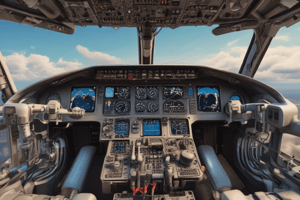Podcast
Questions and Answers
What is the primary function of Integrated Modular Avionics (IMA) in modern aircraft?
What is the primary function of Integrated Modular Avionics (IMA) in modern aircraft?
- To provide a backup power source for essential avionics in case of engine failure.
- To isolate critical avionics systems from non-essential passenger entertainment systems.
- To distribute real-time computing across a network of modules, supporting various applications. (correct)
- To centralize all mechanical flight controls into a single unit for enhanced precision.
Which of the following is a direct benefit of implementing Integrated Modular Avionics (IMA)?
Which of the following is a direct benefit of implementing Integrated Modular Avionics (IMA)?
- Reduction in the weight of the avionics suite. (correct)
- Simplified maintenance of pneumatic components.
- Improved aerodynamic efficiency of the aircraft's wings.
- Increased redundancy in hydraulic systems.
What is the purpose of linking Modular Avionics Units (MAUs) via data buses and discretes in the Embraer 170/190 IMA system architecture?
What is the purpose of linking Modular Avionics Units (MAUs) via data buses and discretes in the Embraer 170/190 IMA system architecture?
- To simplify the power distribution network.
- To isolate each MAU for security purposes.
- To facilitate communication and data exchange between MAUs and aircraft systems. (correct)
- To provide redundancy in case of MAU failure.
Which of the following is an advantage of using Integrated Modular Avionics (IMA) over traditional avionics systems?
Which of the following is an advantage of using Integrated Modular Avionics (IMA) over traditional avionics systems?
How does the implementation of Integrated Modular Avionics (IMA) contribute to operational efficiency?
How does the implementation of Integrated Modular Avionics (IMA) contribute to operational efficiency?
What is a key characteristic of the computing modules (hardware) within an Integrated Modular Avionics (IMA) system regarding the software applications they support?
What is a key characteristic of the computing modules (hardware) within an Integrated Modular Avionics (IMA) system regarding the software applications they support?
According to the information, what is the impact of Integrated Modular Avionics on the A380 avionics suite as compared to traditional systems?
According to the information, what is the impact of Integrated Modular Avionics on the A380 avionics suite as compared to traditional systems?
What is the primary purpose of the transformer coupler within the Avionics Standard-Communication Bus (ASCB) coupler?
What is the primary purpose of the transformer coupler within the Avionics Standard-Communication Bus (ASCB) coupler?
What function do ASCB terminators perform within the Avionics Standard-Communication Bus system?
What function do ASCB terminators perform within the Avionics Standard-Communication Bus system?
Which protocol is used by the Local Area Network (LAN) to allow peripheral devices to communicate with the NIC?
Which protocol is used by the Local Area Network (LAN) to allow peripheral devices to communicate with the NIC?
What is the main purpose of the Local Area Network (LAN) in the context of aircraft avionics?
What is the main purpose of the Local Area Network (LAN) in the context of aircraft avionics?
Which of the following is NOT a listed application of cockpit and flight controls?
Which of the following is NOT a listed application of cockpit and flight controls?
What is the primary function of the Input/Output Module (IOM) within the Avionics Data Communication Network (ADCN)?
What is the primary function of the Input/Output Module (IOM) within the Avionics Data Communication Network (ADCN)?
At what frequency does the Controller Area Network (CAN) bus operate?
At what frequency does the Controller Area Network (CAN) bus operate?
What type of cable is used for the Local Area Network (LAN)?
What type of cable is used for the Local Area Network (LAN)?
Which of the following components are directly connected to the Avionics Data Communication Network (ADCN)?
Which of the following components are directly connected to the Avionics Data Communication Network (ADCN)?
What is the underlying technology that supports the Avionics Data Communication Network (ADCN)?
What is the underlying technology that supports the Avionics Data Communication Network (ADCN)?
Which of the following best describes the nature of the Controller Area Network (CAN) bus?
Which of the following best describes the nature of the Controller Area Network (CAN) bus?
Besides the ASCB, where else is the same wire and harness construction (twisted, shielded pair with terminators) used?
Besides the ASCB, where else is the same wire and harness construction (twisted, shielded pair with terminators) used?
Which of the following is NOT an advantage provided by AFDX technology?
Which of the following is NOT an advantage provided by AFDX technology?
What is the Network Interface Controller's (NIC) function in a Local Area Network (LAN)?
What is the Network Interface Controller's (NIC) function in a Local Area Network (LAN)?
What requirement might need to be fulfilled when swapping IMAs within a specific type?
What requirement might need to be fulfilled when swapping IMAs within a specific type?
Which system does not have a dedicated IMA on a B787, according to the text?
Which system does not have a dedicated IMA on a B787, according to the text?
For the B787, what is the purpose of IMAs related to environment control systems?
For the B787, what is the purpose of IMAs related to environment control systems?
Which of these systems are controlled and indicated by IMAs related to mechanical systems?
Which of these systems are controlled and indicated by IMAs related to mechanical systems?
In the context of the Embraer 170/190, what does MAU stand for?
In the context of the Embraer 170/190, what does MAU stand for?
How is the Integrated Modular Avionics implemented on the A380 compared to the Embraer 170/190?
How is the Integrated Modular Avionics implemented on the A380 compared to the Embraer 170/190?
In a B787, which of the following falls under the control and indication functions managed by the 'Payloads' IMAs?
In a B787, which of the following falls under the control and indication functions managed by the 'Payloads' IMAs?
Which systems are covered by propulsion/APU IMAs?
Which systems are covered by propulsion/APU IMAs?
What is the purpose of IMAs related to electrical systems mentioned in the text?
What is the purpose of IMAs related to electrical systems mentioned in the text?
Which function is associated with the fuel systems IMAs mentioned in the text?
Which function is associated with the fuel systems IMAs mentioned in the text?
What is the primary function of Core Processing Input/Output Modules (CPIOMs) within the A380's Integrated Modular Avionics (IMA) system?
What is the primary function of Core Processing Input/Output Modules (CPIOMs) within the A380's Integrated Modular Avionics (IMA) system?
What is the Avionics Data Communication Network (ADCN) used for in the A380 IMA system?
What is the Avionics Data Communication Network (ADCN) used for in the A380 IMA system?
What communication technology is used by the A380 Integrated Modular Avionics (IMA) system?
What communication technology is used by the A380 Integrated Modular Avionics (IMA) system?
What is the purpose of Input/Output Modules (IOMs) in the A380's Integrated Modular Avionics (IMA) system?
What is the purpose of Input/Output Modules (IOMs) in the A380's Integrated Modular Avionics (IMA) system?
How do applications within the Core Processing Input/Output Modules (CPIOMs) communicate with each other and with conventional LRUs?
How do applications within the Core Processing Input/Output Modules (CPIOMs) communicate with each other and with conventional LRUs?
What type of applications is NOT supported by any of the seven CPIOM types (A to G) mentioned for the A380?
What type of applications is NOT supported by any of the seven CPIOM types (A to G) mentioned for the A380?
How many types of CPIOMs are identified in the A380's IMA system, and what distinguishes them?
How many types of CPIOMs are identified in the A380's IMA system, and what distinguishes them?
What is a key difference between the Integrated Modular Avionics (IMA) system of an Airbus A380 and that of an Embraer 170/190 aircraft?
What is a key difference between the Integrated Modular Avionics (IMA) system of an Airbus A380 and that of an Embraer 170/190 aircraft?
Which of the following best describes the role of the Core Processing Input/Output Module (CPIOM) in the A380's avionics architecture?
Which of the following best describes the role of the Core Processing Input/Output Module (CPIOM) in the A380's avionics architecture?
In the context of the A380's Integrated Modular Avionics (IMA) system, what does the term 'LRM' stand for, and what significance do LRMs hold within this system?
In the context of the A380's Integrated Modular Avionics (IMA) system, what does the term 'LRM' stand for, and what significance do LRMs hold within this system?
Flashcards
Integrated Modular Avionics (IMA)
Integrated Modular Avionics (IMA)
A distributed real-time computer network in aircraft with multiple computing modules.
CPIOM
CPIOM
Core Processing Input/Output Modules that handle data processing in avionics.
Modular Avionics Units (MAUs)
Modular Avionics Units (MAUs)
Hardware components linked by data buses in IMA systems.
Advantages of IMA
Advantages of IMA
Signup and view all the flashcards
Data Buses
Data Buses
Signup and view all the flashcards
Payload Factor
Payload Factor
Signup and view all the flashcards
Safety Criticality Levels
Safety Criticality Levels
Signup and view all the flashcards
Bus Coupler
Bus Coupler
Signup and view all the flashcards
ASCB Terminators
ASCB Terminators
Signup and view all the flashcards
Local Area Network (LAN)
Local Area Network (LAN)
Signup and view all the flashcards
NIC
NIC
Signup and view all the flashcards
Controller Area Network (CAN)
Controller Area Network (CAN)
Signup and view all the flashcards
Transfer Control Protocol/Internet Protocol (TCP/IP)
Transfer Control Protocol/Internet Protocol (TCP/IP)
Signup and view all the flashcards
Twisted, Shielded Pair Wiring
Twisted, Shielded Pair Wiring
Signup and view all the flashcards
Signal Absorption
Signal Absorption
Signup and view all the flashcards
Multi-point Serial Synchronous Communication
Multi-point Serial Synchronous Communication
Signup and view all the flashcards
ADCN
ADCN
Signup and view all the flashcards
AFDX
AFDX
Signup and view all the flashcards
AFDX advantages
AFDX advantages
Signup and view all the flashcards
LRM
LRM
Signup and view all the flashcards
A380 IMA System
A380 IMA System
Signup and view all the flashcards
CPIOM Types
CPIOM Types
Signup and view all the flashcards
Pneumatic Applications
Pneumatic Applications
Signup and view all the flashcards
Air Conditioning Applications
Air Conditioning Applications
Signup and view all the flashcards
CPIOM Data Processing
CPIOM Data Processing
Signup and view all the flashcards
B787 IMA Applications
B787 IMA Applications
Signup and view all the flashcards
Line Replaceable Modules (LRM)
Line Replaceable Modules (LRM)
Signup and view all the flashcards
A380 Avionics Structure
A380 Avionics Structure
Signup and view all the flashcards
Aircraft System Control
Aircraft System Control
Signup and view all the flashcards
Crew Alerting Systems
Crew Alerting Systems
Signup and view all the flashcards
Data Loading and Configuration Management
Data Loading and Configuration Management
Signup and view all the flashcards
Environmental Control Systems
Environmental Control Systems
Signup and view all the flashcards
Propulsion/APU Role
Propulsion/APU Role
Signup and view all the flashcards
Study Notes
Integrated Modular Avionics (IMA) Learning Objectives
- Integrated modular avionics (IMA) is a distributed real-time computer network aboard an aircraft.
- IMA consists of computing modules (hardware) capable of supporting numerous applications (software) of differing safety criticality levels.
- IMA reduces maintenance costs and increases reliability by using fewer computers.
- IMA gives economies in fuel savings and increases payload.
- IMA reduces workload for flight crew and maintenance personnel.
- IMA enables multiple functions to be achieved with a single Line Replaceable Unit (LRU).
- The IMA approach has reduced avionics suite weight, specifically in the 787 Dreamliner and A380.
Modular Avionics Unit (MAU)
- MAUs are hardware and software technologies.
- MAUs host independent applications.
- MAUs supply an input/output interface to some conventional avionics.
- MAU's consist of a backplane to connect LRMs, power supply, and a network interface controller (NIC).
Modular Avionics Unit (MAU) Channel Components
- Backplane: LRMs are plugged to a virtual backplane bus for power and communication.
- Power Supply: Translates aircraft power to conditioned power for the MAU boards.
- NIC: Acts as a gateway for modules to access ASCB/LAN buses.
- User Modules: Third-party modules performing aircraft control and monitoring functions.
- Uses digital Engine Operating System (DEOS).
Typical Integrated Modular Avionics Architecture (Embraer 170/190)
- The IMA system consists of Modular Avionics Units (MAUs) linked by data buses.
- MAUs are linked to various aircraft systems.
Modular Avionics Unit (detailed)
- The MAU is a metal cabinet.
- The cabinet houses different replaceable modules (LRMs).
- Connects to the aircraft wiring through front connectors on the LRMs.
- Each MAU has two independent processing systems (channels) for redundancy.
Data Communication
- MAUs use Avionics Standard Communication Bus (ASCB) for major subsystem communication.
- ASCB uses a high-speed serial data bus (10Mb/s) with a single-shielded twisted pair of wires.
- Data is transmitted in 12.5 millisecond (ms) frames.
- Redundancy in the ASCB network is via four data buses (Left primary, Right primary, Left backup, Right backup).
Avionics Standard Communication Bus Coupler
- Coupler isolates buses (primary, backup, cross-side).
- Uses a transformer coupler for isolation from each other.
Avionics Standard Communication Bus Terminators
- Devices at the endpoints of an ASCB.
- Absorb signals to avoid reflection back down the line.
Local Area Network (LAN)
- Physically and electrically separate from the ASCB.
- Used for development, maintenance, and software loading.
- Uses Ethernet (TCP/IP) for communication between display units, MAU, and peripherals.
Controller Area Network (CAN)
- Standard industrial bus with integrated circuits.
- Operates at 500 kHz.
- Bidirectional serial bus.
- Uses same wire and harness as ASCB.
Error Capabilities
- CAN has error detection on frames.
- Disregards frames with errors, allowing the network to recover.
- Includes mechanisms for nodes to disconnect from network upon too many errors detected.
Typical Integrated Modular Avionics Version of Flight Guidance System (E170/190)
- The Embraer 190 autopilot functions are part of the Flight Guidance Control System (FGCS).
- The FGCS drives autopilot systems using electro-mechanical servo assemblies.
- Actuator Input-Output Processors (AIOPs) handle autopilot and yaw damper functions and act as line replaceable modules (LRM).
- AIOPs receive data from avionics and flight control systems via the ASCB or FGCS.
- IOMs convert non-AFDX data to AFDX data for use in ADCN and vice-versa.
- All IOMs are fully interchangeable.
Autopilot Feedback
- Linear Variable Differential Transformers (LVDTs) provide analog feedback to Primary Actuator Control Electronics (P-ACE) system.
- P-ACE converts analog feedback to digital, then sends it to Flight Control Modules (FCMs) and the Autopilot AIOPs.
- Signals for pitch and horizontal stabilizer control are handled by combining the rudder/trim signals with configuration trim and relayed to the Horizontal stabilizer through the CAN bus.
Types of Integrated Modular Avionics
- Depending on aircraft type and systems, IMAs have different applications but can be interchangeable with reconfiguration.
- Examples: Avionics, displays, crew alerting flight data, thrust management, communication, environmental control, electrical systems, fuel systems, hydraulics, mechanical systems (brakes, landing gear), payloads (lavatories, oxygen), propulsion/APU (engines and APU related control/monitoring).
Comparison of Boeing B777 and B787 Avionics Systems
- Shows differences in the number of Line Replaceable Units (LRUs).
- Highlights reduction in cost, weight, rack space, improved reliability, and reduced wiring.
Difference between EMB 170/190 and A380 IMA
- EMB 170/190 uses a metal cabinet (MAU) with replaceable modules (LRMs) for different applications.
- A380 has independent LRMs, each typically handling multiple systems concurrently.
Integrated Modular Avionics System on the A380
- Uses Core Processing Input/Output Modules (CPIOMs) for independent applications.
- Uses Input/Output Modules (IOMs) for conventional avionics integration.
- Uses Avionics Data Communication Network (ADCN) which is based on AFDX (Avionics Full DupleX) switched Ethernet.
Core Processing Input/Output Module (CPIOM)
- CPIOMs integrate shared memory and computing resources for independent avionics application execution.
- CPIOM: processes specific input/output (I/O) data for each application.
- Seven types of CPIOM, each handling specific (engine bleed air, air conditioning, etc) systems on the aircraft.
Input/Output Module (IOM)
- IOMs do not host avionics applications.
- IOM: converts non-AFDX data from conventional LRUs to AFDX data for the ADCN.
Avionics Data Communication Network (ADCN)
- Based on AFDX technology for secure and reliable communication.
- Utilizes switches, cables, and the AFDX technology to support high data rates (~10 Mb/s or 100 Mb/s) in the system.
- Redundancy in the ADCN system is available to ensure continuity of communication lines.
AFDX World
- AFDX cable is a full-duplex physical link between a subscriber (such as a CPIOM) to an AFDX Switch.
Typical Integrated Modular Avionics Version of Bleed Air Management (A380)
- Bleed air system management is handled by one or more CPIOMs.
- Using signals from the Electronic Control Box (ECB) and responding to user inputs from panels, CPIOMs trigger actions in relation to the bleed air system and related systems.
- Overheat detection unit (OHDU) will trigger responses in related systems if a bleed air leak is detected.
Typical Leak Detection
- Overheat Detection Unit (OHDU) signals the appropriate CPIOM in response to detected bleed air leaks.
- Flight Warning System (FWS), Control and Display System (CDS), and Onboard Maintenance System (OMS) are notified of the incident.
Studying That Suits You
Use AI to generate personalized quizzes and flashcards to suit your learning preferences.



